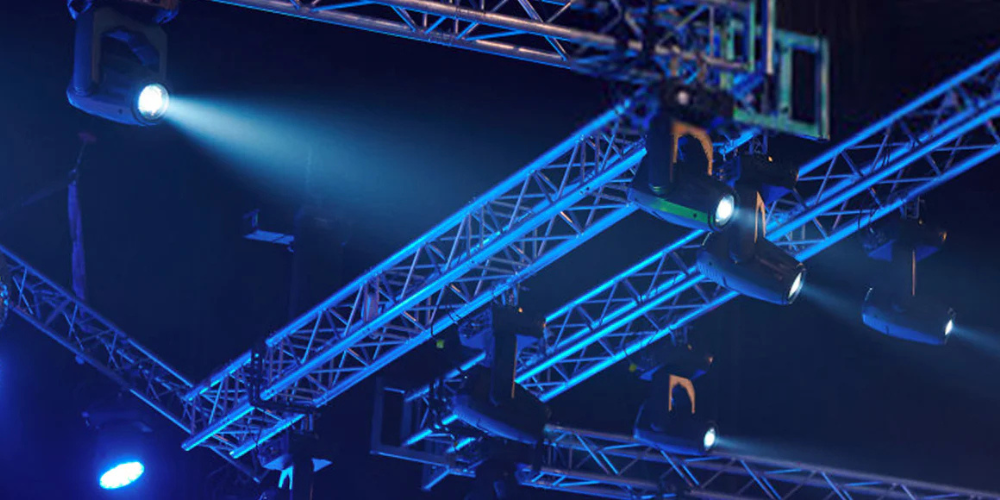L'éclairage scénique est un outil puissant qui va au-delà de la simple illumination d'un espace. C'est une forme d'art qui façonne l'expérience du public lors d'un spectacle. Qu'il s'agisse d'une production théâtrale, d'un concert ou d'un récital de danse, l'éclairage d'une scène peut sublimer la narration, souligner les moments importants et susciter les émotions du public.
Dans ce guide, nous aborderons les fondamentaux de l'éclairage scénique. Nous commencerons par comprendre pourquoi l'éclairage scénique est nécessaire, puis explorerons les termes clés, les différents types d'éclairages, les positions et les couleurs. Enfin, nous verrons comment collaborer efficacement avec un concepteur lumière pour donner vie à votre vision. Que vous soyez novice ou que vous souhaitiez rafraîchir vos connaissances, ce guide vous accompagnera.
Pourquoi l'éclairage de scène est nécessaire
L'éclairage scénique joue un rôle essentiel dans tout spectacle, et son importance ne saurait être surestimée. Voyons pourquoi il est si crucial :
Éclairage la scène
À la base, l'éclairage scénique est nécessaire pour rendre les artistes et le décor visibles au public. Sans un éclairage adéquat, une grande partie de l'action sur scène serait perdue dans l'ombre. Mais il ne s'agit pas seulement de visibilité, mais de clarté. Un éclairage efficace permet de percevoir chaque mouvement, geste et expression faciale, ce qui est particulièrement important pour transmettre l'émotion et l'intention d'une performance.
Mettre en évidence les domaines clés
L'éclairage scénique ne consiste pas seulement à inonder la scène de lumière. Il s'agit de mettre en valeur sélectivement différentes zones pour capter l'attention du public. Des projecteurs permettent de mettre en valeur un soliste, tandis que des faisceaux lumineux plus doux et plus larges permettent de mettre en valeur un ensemble. En mettant en valeur des zones spécifiques, l'éclairage guide le regard du public vers les points les plus importants de l'action.
Définir la scène
L'éclairage joue également un rôle crucial dans la mise en scène et l'établissement du moment et du lieu de la représentation. Par exemple, une lumière chaude et dorée peut suggérer une journée ensoleillée, tandis que des tons bleus froids peuvent indiquer la tombée de la nuit ou un environnement frais. Au-delà de la simple couleur, l'intensité et la direction de la lumière peuvent également suggérer différents moments de la journée, conditions météorologiques, voire états émotionnels.
Contrôle le Atmosphère
L'un des aspects les plus puissants de l'éclairage scénique est peut-être sa capacité à contrôler l'ambiance d'une scène. Grâce à l'utilisation de couleurs, d'intensités et de motifs variés, les concepteurs lumière peuvent susciter un large éventail d'émotions, de la joie et de l'excitation à la peur et au suspense. Par exemple, une scène baignée de lumière rouge peut créer un sentiment de danger ou d'urgence, tandis qu'un éclairage doux et diffus peut suggérer le calme ou le romantisme.
Termes relatifs à l'éclairage de scène Toi Besoin de Savoir
Avant d'aborder plus en détail les spécificités de l'éclairage scénique, il est important de se familiariser avec certains termes clés couramment utilisés dans ce domaine. Comprendre ces termes vous aidera à communiquer plus efficacement avec votre concepteur lumière et votre équipe.
Lanterne
En éclairage scénique, le terme « lanterne » est souvent utilisé de manière interchangeable avec « luminaire ». Il s'agit d'un terme général qui désigne tout type d'instrument d'éclairage utilisé sur scène pour éclairer les artistes et le décor.
Lampes
Les lampes sont les véritables sources lumineuses à l'intérieur des lanternes. Elles produisent la lumière que le luminaire façonne et dirige. Différents types de lampes (tungstène, halogène ou LED) offrent différents niveaux de luminosité, de température de couleur et d'efficacité énergétique.
Laver
Un « wash » désigne une diffusion lumineuse large et uniforme sur une grande surface de la scène. Les projecteurs wash assurent un éclairage général, garantissant la visibilité des artistes et des éléments de décor. Ils sont essentiels pour créer une couche de lumière uniforme sur toute la scène.
Intensité
L'intensité désigne la luminosité d'une lumière. Ajuster l'intensité peut radicalement changer l'ambiance d'une scène, d'une douce lueur romantique à un éclairage intense et éblouissant. Les concepteurs lumière contrôlent l'intensité pour attirer l'attention ou créer une ambiance émotionnelle.
Diffusion
La diffusion désigne la technique d'adoucissement de la lumière. Elle est souvent obtenue en plaçant un filtre ou un diffuseur devant la lampe, ce qui disperse la lumière, réduisant ainsi les ombres trop marquées et créant une diffusion plus naturelle et uniforme.
Gel
Les gélatines sont des filtres colorés placés devant une lanterne pour modifier la couleur de la lumière. Elles sont essentielles pour créer une ambiance, indiquer l'heure de la journée ou représenter des lieux précis lors d'une représentation.
Gobo
Un gobo est un pochoir ou un motif découpé dans une plaque de métal ou de verre et placé devant un projecteur pour projeter des formes, des textures ou des images sur la scène. Les gobos ajoutent un intérêt visuel et peuvent transformer l'apparence d'une scène.
Nez
Un snoot est un accessoire cylindrique placé sur une lanterne pour contrôler la diffusion de la lumière et l'empêcher de se répandre sur des zones indésirables de la scène. Il permet de focaliser la lumière avec plus de précision, idéal pour créer des faisceaux serrés ou des effets ponctuels.
Cyclorama
Un cyclorama (ou « cyc ») est un grand décor souvent incurvé situé au fond de la scène. Il est généralement éclairé par une lumière colorée créant l'illusion d'un ciel, d'un paysage ou d'un arrière-plan abstrait, ajoutant ainsi de la profondeur et un contexte visuel à la scène.
Ces termes constituent l’épine dorsale de l’éclairage de scène, contribuant à façonner le récit visuel de toute performance.
Types d'appareils d'éclairage de scène
Maintenant que nous avons abordé quelques notions de base, examinons les différents types d'éclairage de scène. Chaque type d'appareil a une fonction spécifique et peut créer divers effets.
1. Projecteurs
Les projecteurs sont des éclairages puissants produisant un faisceau focalisé, généralement utilisés pour mettre en valeur un artiste ou une zone spécifique de la scène. Souvent actionnés manuellement, ils permettent à la lumière de suivre le déplacement de l'artiste sur scène. Les projecteurs sont essentiels pour attirer l'attention sur les moments clés d'une représentation.
2. Fresnels
Les Fresnels sont des luminaires polyvalents qui produisent un faisceau lumineux aux contours doux, réglable pour une focalisation plus ou moins importante. Ils sont couramment utilisés pour éclairer de grandes zones de la scène ou pour créer un effet de vague. Ils sont parfaits pour un éclairage général sans créer d'ombres trop marquées.
3. Ellipsoïdaux (LEKO)
Les projecteurs ellipsoïdaux, également appelés LEKO, produisent un faisceau net et focalisé, modelable et manipulable à l'aide de volets ou de gobos. Ces projecteurs sont parfaits pour mettre en valeur des zones spécifiques de la scène, comme une entrée ou un artiste en particulier. Ils sont souvent utilisés en conjonction avec des gobos pour projeter des motifs ou des images.
4. Canettes PAR
canettes PAR Ce sont des luminaires simples et robustes qui produisent un faisceau lumineux puissant et dirigé. Ils sont couramment utilisés pour l'éclairage des concerts et pour ajouter des effets de couleur sur scène. Les boîtiers PAR sont souvent utilisés en plusieurs exemplaires pour créer un champ lumineux large et uniforme.
5. Lumières LED
Les lumières LED sont devenues de plus en plus populaires dans l’éclairage de scène en raison de leur efficacité énergétique, de leur longue durée de vie et de leur polyvalence.Elles peuvent produire une large gamme de couleurs sans gel et sont souvent utilisées pour les effets de lumière, le rétroéclairage et les effets spéciaux. De plus, les LED sont programmables, ce qui les rend idéales pour les changements d'éclairage dynamiques pendant une représentation.
6. Projecteurs à tête mobile
Projecteurs à tête mobileLes projecteurs à tête mobile, aussi appelés éclairages intelligents, sont des appareils très polyvalents capables de pivoter, d'incliner et de modifier la couleur, la forme du faisceau et le motif. Souvent contrôlés par ordinateur, ces projecteurs permettent de créer des effets lumineux complexes et synchronisables avec la performance. Les projecteurs à tête mobile sont couramment utilisés lors de concerts, de productions théâtrales et d'événements où l'éclairage dynamique est essentiel. Leur capacité à créer une large gamme d'effets en fait un outil de choix pour ajouter énergie et mouvement à un spectacle.
Quels sont les Typique Positions d'éclairage?
Le positionnement de vos lumières est tout aussi important que le type d'éclairage utilisé. Différentes positions d'éclairage créent des effets différents et peuvent influencer considérablement la perception d'une scène.
Éclairage avant
L'éclairage frontal est la position d'éclairage la plus basique et la plus courante. Il éclaire les artistes et le décor de face. Il permet au public de voir clairement l'action sur scène. Cependant, se fier uniquement à l'éclairage frontal peut produire des images plates et bidimensionnelles ; c'est pourquoi il est souvent utilisé en combinaison avec d'autres positions d'éclairage.
Rétroéclairage
Le rétroéclairage consiste à placer des lumières derrière les artistes, créant ainsi un effet de silhouette. Ce type d'éclairage ajoute de la profondeur et de l'intensité à une scène, soulignant les contours et le mouvement des artistes. Le rétroéclairage est souvent utilisé dans les spectacles de danse et les concerts pour créer un impact visuel saisissant.
Éclairage latéral
L'éclairage latéral est placé sur les côtés de la scène et permet de mettre en valeur les contours des interprètes, créant ainsi une impression de tridimensionnalité. Il est particulièrement efficace dans les spectacles de danse, où il accentue le mouvement et la forme des danseurs.
Éclairage zénithal
L'éclairage zénithal, comme son nom l'indique, consiste à placer des lumières au-dessus de la scène. Ce type d'éclairage permet de créer un effet naturel, simulant la lumière du soleil ou d'autres sources de lumière naturelle. Il peut également servir à mettre en valeur des zones spécifiques ou à créer des ombres spectaculaires.
Éclairage vers le haut
L'éclairage vers le haut consiste à placer des lumières au sol, pointées vers le haut. Cet angle inhabituel peut créer des effets étranges ou dramatiques, souvent utilisés dans les scènes d'horreur ou de suspense. L'éclairage vers le haut peut également servir à mettre en valeur des éléments scéniques ou à créer une atmosphère surnaturelle.
Réflexions finales
L'éclairage scénique est un élément essentiel de toute représentation, façonnant l'expérience du public. De l'éclairage de la scène à la mise en scène en passant par la gestion de l'ambiance, une conception lumière efficace peut transformer une production en un moment inoubliable. En maîtrisant les bases des luminaires, des positions, des couleurs et des textures, et en collaborant étroitement avec un concepteur lumière compétent, vous pouvez créer une performance visuellement époustouflante et émotionnellement puissante.
N'oubliez pas que l'éclairage n'est pas seulement une question de visibilité, mais aussi de narration. Chaque lumière, couleur et ombre contribue à la narration et guide le public à travers le parcours que vous avez créé sur scène. Que vous soyez novice en éclairage scénique ou que vous cherchiez simplement à vous perfectionner, ce guide vous donnera les outils nécessaires pour éclairer votre prochaine production.



Laisser un commentaire
Tous les commentaires sont modérés avant d'être publiés.
Ce site est protégé par hCaptcha, et la Politique de confidentialité et les Conditions de service de hCaptcha s’appliquent.